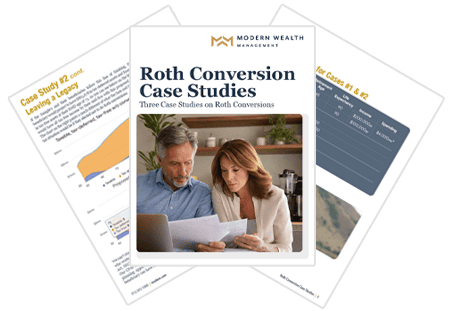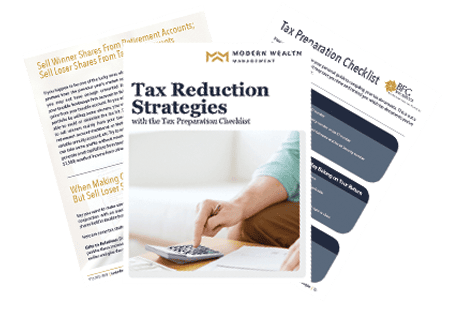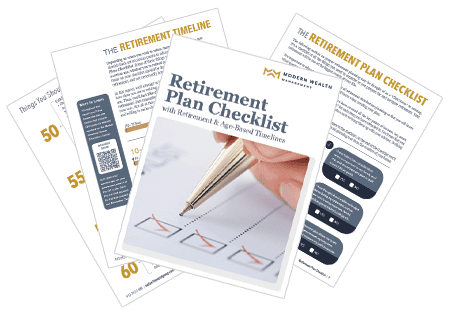Setting Up Your Portfolio for Retirement
Key Points – Setting Up Your Portfolio for Retirement
- How Should You Go About Setting up Your Portfolio for Retirement?
- Important Variables to Consider During the Retirement Planning Process
- Understanding Your Cash Flow in Retirement
- What Does It Mean to Stress Test Your Financial Plan?
- 8 Minutes to Read | 23 Minutes to Watch
Setting Up Your Portfolio to Get You to AND Through Retirement
It’s one thing to know what age you want to retire, but it’s another to know you can get to and through retirement without too much financial stress. How much do you need to live your desired lifestyle in retirement? That answer is different for everyone. Let’s review a few steps to help you make sure your retirement portfolio can go the distance.
Schedule a Meeting Get the Retirement Plan Checklist
Step 1 to Set Up Your Portfolio for Retirement: Begin Building a Financial Plan
Hopefully you’ve been diligent about saving for retirement, but the question from the first paragraph remains. How are you supposed to know how much you need to save? To get your personalized answer, you need to have a forward-looking financial plan. The process of building your financial plan should begin with you (and your partner, if applicable) laying out your needs, wants, and wishes in retirement.
Since we don’t know what your specific needs, wants, and wishes are, we can’t give you the answer to how much you need to save for retirement in this article. We also don’t know how much you’ve saved so far and where you’ve saved to. That is some of the first information we gather from prospective clients.
How Much Do You Plan to Spend Each Month in Retirement?
In case you missed it on The Guided Retirement Show, two of our CFP® Professionals, Logan DeGraeve, CFP®, AIF® and Chris Rett, CFP®, AIF®, went through a case study for a sample couple who planned to spend $10,000 a month in retirement. You can see some of the other details from the case study that Chris and Logan reviewed below.
- Planned Retirement Age: 65 (for John and Jane)
- Keep in mind that 65 is the age you become eligible for Medicare.
- Social Security: $2,465 a month for the higher earner; $1,232 a month for the lower earner
- Portfolio Allocation: 60% equities and 40% fixed income
- Inflation Rate: 4% for general expenses; 6.5% for health care costs
- Life Expectancy: 78 for John; 84 for Jane
- Understanding that tax rates are scheduled to sunset after 2025
- All retirement savings in tax-deferred accounts
There are a lot of important variables in the points above. And that’s just the start of building your financial plan. Maybe you don’t think you’ll need to spend $10,000 a month in retirement. Or maybe you’ll want to spend more? Even if you plan to spend $10,000 a month, understand that the portfolio that you set up for retirement will be much different than the sample retirement portfolio for John and Jane.
It truly depends on what you want your lifestyle to look like in retirement. If you want to travel more and that’s one of your top priorities, let’s make sure that your desired trips are built into your plan. It’s also critical to budget for unexpected expenses, such a new HVAC system, a new car, or helping a child or grandchild.
When Do You Plan to Retire?
Do you and your partner plan to retire at 65 like the Client’s? According to the Alliance for Lifetime Income Retirement Income Institute, more than 4 million people who are projected to retire in 65 in 2024.1 This trend, known as Peak 65, has put several concerns about retirement planning under a bigger spotlight.
One of those concerns are high health care costs in retirement, and many people wait until 65 to retire because of it. That’s because 65 is the age that you become eligible for Medicare. The thought of going to the marketplace for health insurance rubs a lot of people the wrong way because of the costs associated with it.
But many people also dread the thought of working until 65. Don’t forget that time is our scarcest resource. Retiring before 65 might be worth paying out of pocket for health care coverage if you can afford it. That is why building a financial plan might help you gain more confidence that you are doing things to help you reach your goals in retirement.
Step 2 to Set Up Your Portfolio for Retirement: Reviewing Your Assets and Cash Flow
Whether you want to retire next year or 10 years from now, it’s important to project what your cash flow is going to look like in retirement. If you’re wanting to retire in the next year and haven’t thought much about retirement cash flow, that needs to become a priority. How are you going to fund your retirement once you no longer have a paycheck? It’s time for your money to start working for you and enjoy the feeling of being financially independent.
Considerations for When to Claim Social Security
Social Security is a major source of income for many retirees. You’re eligible to begin claiming your Social Security benefits at 62. However, the longer that you delay claiming Social Security, the larger the benefit will be once you claim it.
It’s also crucial to realize that the decision of when to claim Social Security isn’t all about you if you have a significant other. We hope that you and your partner live long and healthy lives. But if you or your partner dies, did you know that the surviving spouse only retains the larger of your two benefits? Also, remember that Social Security by itself is a tax-free resource, but up to 85% of your benefit can become taxable when it’s combined with other assets.
Roth vs. Traditional
Speaking of taxes on retirement income, it’s pivotal to understand that if you’ve saved, for example, $1.5 million to a traditional 401(k), that you don’t actually have $1.5 million. That’s because the contributions you’ve been making have yet to be taxed. On the other hand, if you’ve been contributing to a Roth 401(k), those funds are being taxed upon the contribution. But from that point on, they’ll grow tax-free.
Understanding the various pros and cons of Roth and traditional assets is pivotal as you’re setting up your portfolio for retirement. That’s because taxes—along with health care—are arguably one of the leading wealth-eroding factors in retirement.
We oftentimes have prospective clients come to us with most of their retirement income in tax-deferred accounts (i.e.: traditional 401(k) or IRAs). If you’re taking withdrawals from those accounts after December 31, 2025, they’ll be taxed at higher rates if the Tax Cuts and Jobs Act sunsets as it’s scheduled to.2
Creating Tax Diversification
If you have most of your retirement income in a traditional 401(k) or IRAs, it’s not too late to create some tax diversification. By having your assets spread between tax-deferred, taxable, and tax-free accounts, you’ll have more tax flexibility in retirement. One way to go about doing this is via Roth conversions—converting funds from a traditional IRA to a Roth IRA. You’re required to pay tax on the conversion, but you can capture tax-free growth after that.
Roth conversions and other forward-looking tax planning strategy can increase your spending power within your portfolio during retirement. But there can also be unintended consequences or Roth conversions and other tax planning strategies. As you’re trying to decide if Roth conversions make sense for you, download our Roth Conversion Case Studies and Tax Reduction Strategies white papers below.


What Other Sources of Retirement Income Do You Anticipate Having?
As you can see with the major differences between Roth and traditional accounts, it’s vital to understand the distribution rules of the assets within your retirement portfolio. You and your partner may have other sources of retirement income besides 401(k)s, IRAs, Roth accounts, and Social Security, too. Do you have a pension, rental income, or other retirement savings?
Short-Term, Intermediate-Term, and Long-Term Buckets
It’s the job of our team to assess our clients’ assets and figure out how to make them work in the most tax efficient manner to accomplish their goals. To manage retirement cash flow effectively, it’s also helpful to diversify your savings and investments into short-term, intermediate, and long-term buckets of money.
The short-term bucket should be comprised of liquid assets that can pay off immediate expenses and emergency needs. Think of it as being a safety net during times of uncertainty—perhaps three to six months of savings.
The intermediate bucket should consist of investments with moderate risk and return potential. The assets in the intermediate bucket can be used within a few years and bridge your short-term needs and long-term growth.
Then, there’s the long-term bucket. It’s comprised of investments with higher growth potential. Assets in the long-term bucket are meant to grow over time, providing you with income and capital appreciation over the duration of your retirement.
Step 3 to Set Up Your Portfolio for Retirement: Stress Testing Your Financial Plan
Now that you’ve laid out a draft of your goals-based financial plan and built a spending plan for retirement, let’s see if you have a plan that can get you to and through retirement. While it all depends on your individual situation, the reason we typically look at strategies like delaying Social Security and doing Roth conversions is because they may be able to allow you to spend more over the course of your retirement.
The additional savings can be immensely impactful if there are big unexpected costs that arise in retirement. We mentioned a few examples of those earlier, but what if you or your partner suddenly requires a long-term care stay? Or what if inflation and interest rates both continue to remain elevated? Can your plan withstand various instances of uncertainty that can derail your retirement if you didn’t consider them?
This is why our team stress tests financial plans against potential worst possible economic outcomes. Stress testing looks at history to help assess if you could successfully get through retirement without needing to adjust your spending or returning to work. We published our Retirement Plan Checklist to help people gauge their ability to retire with a high probability of success. Review the financial planning considerations within our Retirement Plan Checklist to make sure that you’re on your way to building a plan that gives you more confidence, freedom, and time.

Reviewing Our Retirement Plan Checklist with Your Partner and a Financial Planning Team
Once you’ve reviewed our Retirement Plan Checklist, make sure to review it with your partner as well. Your partner’s needs, wants, and wishes need to be included as you’re setting up your portfolio for retirement. If you’re already working with a financial advisor, go through the 30-question checklist that’s within the white paper to see if they can answer every question.
We want to ensure that all your wealth management needs are covered—from tax planning and estate planning to investment management and risk management. And, of course, your retirement goals. That’s exactly why we’ve built a team of professionals at Modern Wealth that consists of CFP® Professionals, CPAs, CFAs, estate planning specialists, and risk management specialists. To learn more about how our team can assist you with setting up your portfolio for retirement, start a conversation with us below.
We’re obligated to put your needs, wants, and wishes first at Modern Wealth. We look forward to the opportunity of building your plan and consistently updating it as your life changes leading up to and during retirement.
Setting Up Your Portfolio for Retirement: Watch Guide
00:00 – Introduction
02:12 – The Financial Plan
06:31 – What Are Your Resources and Cashflow?
12:55 – Stress Testing the Financial Plan (Break It!)
17:06 – Asking the Right Questions
19:38 – What We Learned Today
Articles
- Have I Saved Enough to Retire?
- How Much Do I Need to Retire?
- Components of a Complete Financial Plan with Logan DeGraeve, CFP®, AIF®
- Starting the Retirement Planning Process
- Setting up a Spending Plan for Retirement
- Planning to Retire on $10,000 a Month with Logan DeGraeve, CFP®, AIF® and Chris Rett, CFP®, AIF®
- Maximizing Social Security Benefits
- Avoiding Costly Mistakes When Claiming Social Security with Ken Sokol
- What to Do with Your 401(k) After Retirement
- Revisiting Roth vs. Traditional with Bud Kasper, CFP®, AIF® and Corey Hulstein, CPA
- Tax Rates Sunset in 2026 and Why That Matters
- What If We Go Back to Higher Tax Rates?
- What Is Tax Diversification?
- Finding Financial Independence
- Why You Need a Financial Planning Team with Jason Gordo
Past Shows
- Retirement Savings by Age
- Financial Stress: How Do You Deal with It?
- Your Retirement Lifestyle: What Do You Want Your Retirement to Look Like?
- Where Should I Be Saving for Retirement?
- Peak 65: Nearly 4.4 Million Americans Projected to Turn 65 in 2024
- Health Care Costs During Retirement
- Time Is Your Scarcest Resource
- Retiring Before 65: What You Need to Consider
- Unexpected Expenses and How to Plan for Them
- When Is It Time to Retire?
- Retirement Cash Flow: What You Need to Know
- Retiring Before 62: What You Need to Consider
- Couples Retirement Planning: What You Need to Know
- Taxes on Retirement Income
- 7 Wealth Protection Tactics
- Converting to a Roth IRA: What Are the Pros and Cons?
- How Does a Roth IRA Grow?
- What Is Tax Planning?
- Pension Plans: Defined Benefit Plans vs. Defined Contribution Plans
- 5 Long-Term Care Questions to Ask
- Is Inflation Still Cooling?
- Planning for Uncertainty in Retirement
- Stress Testing Your Financial Plan
- Don’t Retire without Doing These Things First
- 5 Financial Planning Considerations
- What’s the Meaning of Wealth Management?
- Skills to Expect of a Financial Advisor
Downloads
Other Sources
[1] https://www.protectedincome.org/peak65/
[2] https://taxfoundation.org/blog/tcja-expiring-means-for-you/
Investment advisory services offered through Modern Wealth Management, LLC, an SEC Registered Investment Adviser.
The views expressed represent the opinion of Modern Wealth Management an SEC Registered Investment Adviser. Information provided is for illustrative purposes only and does not constitute investment, tax, or legal advice. Modern Wealth Management does not accept any liability for the use of the information discussed. Consult with a qualified financial, legal, or tax professional prior to taking any action.